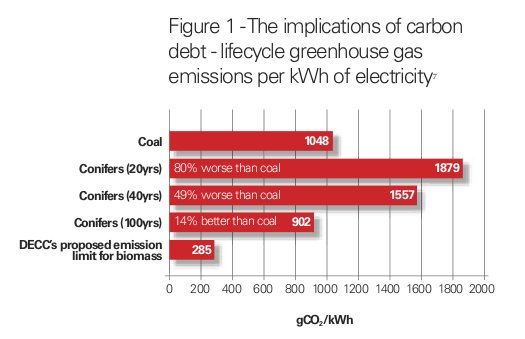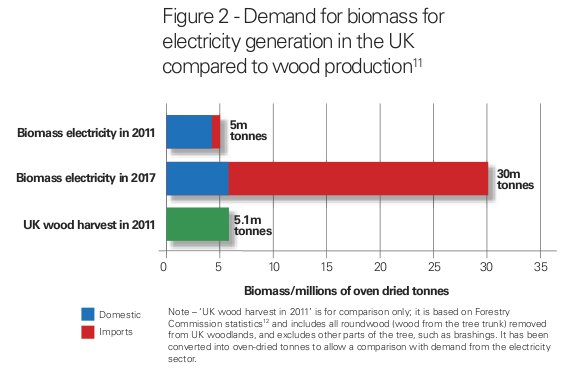The Leeds City Region Green Economy Panel is promoting large-scale biomass electricity generation at the Drax power station near Leeds.
Like many members of the public, the Green Economy Panel members probably assume that burning wood and other biomass is carbon neutral. In other words – that burning wood and other biomass doesn’t add to carbon dioxide in the atmosphere, because new forest growth will absorb and store the carbon emissions released when the wood is burned. This isn’t the case – the European Environment Agency calls the assumption “ a serious accounting error”.
The Department of Energy and Climate Change (DECC) admits that the reason for promoting and subsidising biomass electricity generation , via the Renewables Obligation, has nothing to do with reducing carbon emissions and climate change, and everything to do with extending the lives of coal-fired power stations that would otherwise have “to close before 2016 under environmental legislation” (Information from DECC about Draft Renewables Obligation (Amendment) Order 2013).
Biomass smokestack carbon emissions are worse than coal’s
According to the US Environmental Protection Agency, at the smokestack, large-scale biomass produces up to 50% more carbon emissions than coal fired power stations, to generate the same amount of electricity.
Biomass is more carbon-intensive than coal and gas, because it produces less energy than these fossil fuels when burnt, so more has to be burnt to produce the same amount of energy.
Different scientific studies give different results for the relative carbon-intensiveness of biomass compared to fossil fuels. In contrast to the US EPA study, the International Panel on Climate Change (IPCC) says that CO2 emissions from burning wood are higher than those from burning most types of coal, though similar to those from burning lignite (brown coal).
Both the US EPA Report and the IPCC Guidelines for National Greenhouse Gas Inventories are cited in the Biofuelwatch Report, Sustainable Biomass: A Modern Myth.
Despite accepting that burning large scale biomass emits more carbon dioxide than most types of coal, the International Panel on Climate Change (IPCC) does not require countries to report biomass smokestack carbon emissions in their overall greenhouse gas emissions reports. Countries are free to ignore this source of carbon emissions, on the assumption that the emissions are neutralised by being absorbed by new-growth forests and other vegetation.
Burning large-scale biomass creates a “carbon debt” and is not carbon neutral over the time frame that matters
Carbon emissions from burning biomass remain in the atmosphere for years and decades before the new growth of forests can take the carbon out of the atmosphere and store it. This creates what is called a carbon debt. Large scale biomass electricity generation can therefore have no role in reducing/mitigating climate change, since the urgent need is for a steep, quick reduction in human-caused carbon emissions over the next few decades.
If concentrations of greenhouse gases in the atmosphere continue to rise over the next decades, climate scientists estimate there is a high degree of probability that it will be impossible to reduce or mitigate climate change.
The Government’s carbon accounting methodology completely ignores the spike in CO2 emissions that will result from large-scale biomass burning, and that will last for several decades before the growth of new trees and vegetation absorb it.
The carbon debt from burning large scale biomass is extremely damaging and dangerous, in terms of worsening climate change. Studies indicate that burning large scale biomass for electricity would be worse for the climate than electricity from fossil fuels for a period of 40- 100 years. Use of large-scale biomass therefore cannot reduce/mitigate climate change. It will in fact make it worse.
Regardless of the time period needed for new-growth forests and other vegetation to reabsorb the carbon emissions from burning large-scale biomass, burning biomass is never even better than the current grid average. It also fails to meet CO2 emissions limits proposed by the Department of Energy and Climate Change.
The carbon debt may never even be repaid by new growth forests, because carbon is emitted not just by burning biomass, but by depleting soils and destroying plant communities as a result of logging.
“A growing number of scientific studies show that burning wood for energy generally results in a carbon debt of decades or even centuries compared with fossil fuels whichmight otherwise have been burnt.” (Sustainable Biomass – A modern myth)
Carbon accounting ignores emissions from indirect land use change
Proposed biomass burning in the UK by 2017 would require the import of 20million tons of oven-dried wood.
Large scale biomass requires monoculture plantations to grow enough trees and other plants to burn. Land for these plantations is often taken from farmers, who then have to use other land to farm. This often involves turning grassland or forests into farmland. The carbon stored in the forests and grasslands is then released into the atmosphere. These carbon emissions are the indirect result of burning large-scale biomass. But they are not accounted for.
Large scale biomass burning in the UK outsources lifecycle carbon emissions to other countries
Lifecycle carbon emissions from burning biomass are the emissions that come from logging, land use change, transport and processing of biomass. All these emissions are the responsibility of the UK, since they are created in order to provide us with electricity. But the countries where they are produced are deemed responsible for the aspects of lifecycle carbon emissions that are currently accounted for, such as transport and processing.
As already discussed, carbon accounting for large-scale biomass ignores the carbon debt and emissions from indirect land use change.
Is it possible to account for lifecycle emissions from large scale biomass?
It’s not at all clear that it’s possible to measure lifecycle carbon emissions from burning large scale biomass, since this is so complex. For example, logging reduces the carbon stored in the soil, and the UK requires this to be included in carbon emissions accounting for biomass sourced in the UK. But this is not a simple matter.
A study from Finland found that removing forestry residues – the bits left over like brash, branches and stumps – depletes soil carbon and soil nutrients and “this alone can result in bioenergy emissions being as high as those from fossil fuels” – before the biomass is even burnt. But different types of forest in different parts of the world have different types of soil which store different amounts of carbon. So there’s no simple way of accounting for the carbon emissions that result from logging.
Soil compaction from logging machinery also increases carbon emissions from soil but the effects on different soils in different forests vary. Estimates or direct measurements of soil carbon emissions from different sites would have to be customised for each site.
Another problem in calculating lifecycle carbon emissions from large scale biomass is that climate change is already happening. This is putting forests and other ecosystems under serious stress. So forests and other vegetation may not regenerate as expected and may be less effective in re-absorbing the carbon emissions created by burning biomass.
Stop subsidies for large scale biomass
Large scale biomass is not carbon neutral over the decades that matter in terms of reducing/mitigating climate change. It will not help reduce climate change. We need to stop subsidising it as a renewable form of energy, and stop including it in climate change reduction plans. Stopping the subsidies would halt the development of the many large-scale biomass power stations that are planned for the UK, and that will make climate change worse.



